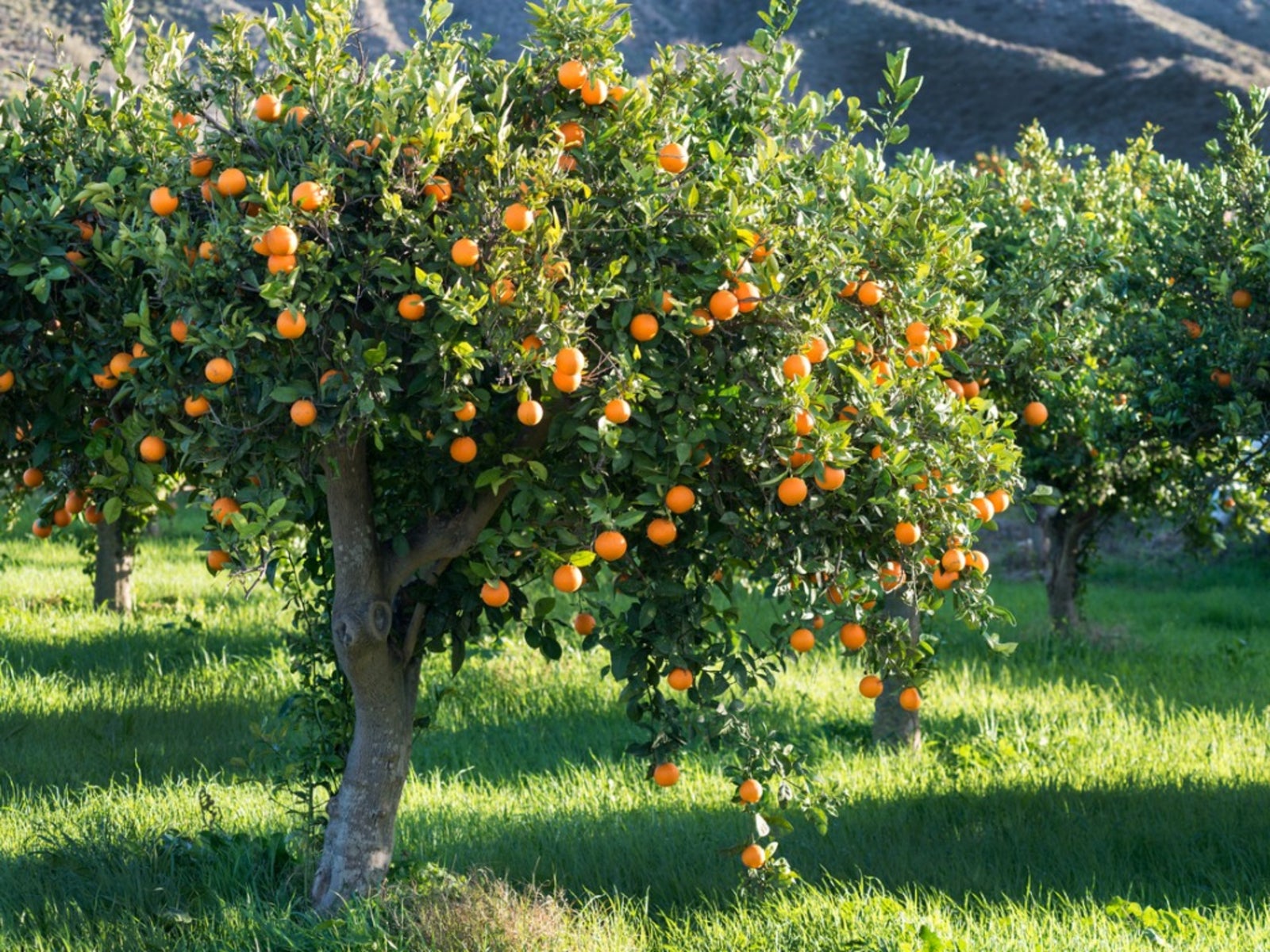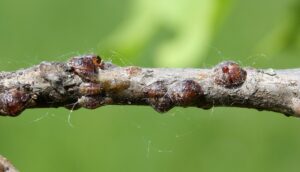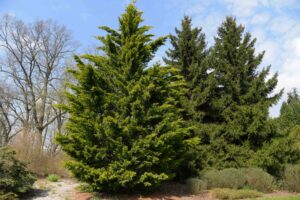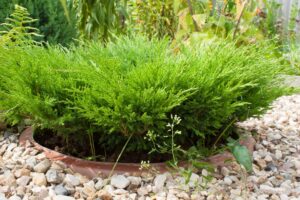Citrus Trees That Grow and Thrive Indoors
There’s something magical about the sweet scent of citrus blossoms filling your home and the satisfaction of plucking fresh fruit from your very own tree. Growing citrus indoors isn’t just possible—it can be remarkably rewarding when you select the right varieties and provide proper care. Whether you live in a snowy northern climate or simply lack outdoor garden space, this guide will help you successfully grow citrus trees indoors and enjoy their vibrant fruits year-round.
Why Grow Citrus Trees Indoors?
Indoor citrus cultivation offers numerous benefits beyond the obvious pleasure of homegrown fruit. These attractive trees serve as beautiful houseplants, with glossy evergreen foliage that brightens your living space. Many varieties produce fragrant blossoms that naturally perfume your home. Plus, having fresh citrus at your fingertips means you’ll always have access to vitamin-rich fruits for cooking, baking, and cocktails.
According to the USDA Agricultural Research Service, citrus fruits are excellent sources of vitamin C, flavonoids, and other beneficial compounds that support immune health and overall wellness. Growing your own ensures the freshest possible fruit without chemical preservatives or waxes often found on store-bought varieties. You can find more information about the nutritional benefits of citrus fruits on the USDA’s Nutrition website.
Best Citrus Varieties for Indoor Growing
Not all citrus trees adapt well to indoor conditions. The following varieties have proven to be particularly successful as houseplants due to their compact size, adaptability to container growth, and reliable fruiting habits.
| Variety | Height Range | Light Requirements | Fruit Size | Time to Harvest | Special Notes |
|---|---|---|---|---|---|
| Meyer Lemon | 3-4 ft | 8-12 hrs direct sun | Medium | 6-9 months | Self-pollinating, everbearing |
| Calamondin Orange | 2-4 ft | 6-8 hrs direct sun | Small | 9-12 months | Very ornamental, tart fruit |
| Kaffir Lime | 3-5 ft | 6-8 hrs direct sun | Small | 8-10 months | Aromatic leaves for cooking |
| Bearss Lime | 3-5 ft | 8-10 hrs direct sun | Medium | 6-9 months | True lime flavor, prolific |
| Kumquat | 2-4 ft | 6-8 hrs direct sun | Very small | 4-6 months | Edible skin, sweet-tart flavor |
| Satsuma Mandarin | 4-6 ft | 8-12 hrs direct sun | Medium | 9-12 months | Easy-peel, sweet fruit |
| Key Lime | 2-4 ft | 6-8 hrs direct sun | Small | 6-9 months | Authentic pie lime, compact |
| Australian Finger Lime | 3-5 ft | 6-8 hrs direct sun | Small, elongated | 10-12 months | Caviar-like pulp vesicles |
Setting Up Your Indoor Citrus Garden
Successfully growing citrus indoors requires attention to several key factors. With proper preparation, you can create an environment where your trees will not just survive but thrive.
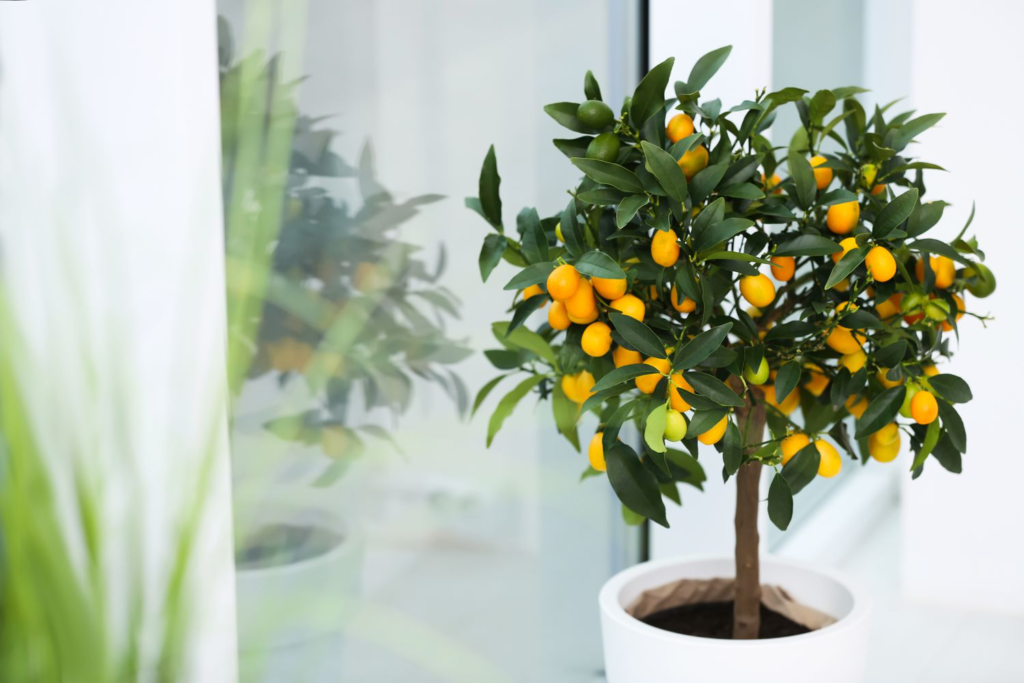
Choosing the Right Container
Your container selection plays a crucial role in your citrus tree’s health and productivity. Here’s what to look for:
- Size matters: Choose a pot that’s slightly larger than the root ball of your tree, typically 12-15 inches in diameter for young trees. This allows room for growth while preventing excess soil that can lead to overwatering issues.
- Drainage is essential: Ensure your container has multiple drainage holes. Citrus trees hate wet feet and are prone to root rot in waterlogged soil.
- Material considerations: Terra cotta pots are ideal as they’re porous and allow soil to breathe, but glazed ceramic, plastic, or fiberglass containers can also work well if they provide adequate drainage.
- Mobility options: Consider placing larger containers on plant caddies with wheels, especially if you’ll need to move your trees outside during summer months or to different windows for optimal light exposure.
Light Requirements
Inadequate light is the most common reason indoor citrus trees fail to thrive. These sun-loving plants require significantly more light than most houseplants:
- Minimum requirements: 6-8 hours of direct sunlight daily is the absolute minimum, with 8-12 hours being ideal.
- Window placement: South-facing windows generally provide the most light, followed by east and west exposures. North-facing windows rarely provide sufficient light for fruiting citrus.
- Seasonal adjustments: During winter months when daylight hours are shorter, you’ll likely need to supplement with grow lights. Full-spectrum LED grow lights positioned 12-18 inches above your tree for 12-14 hours daily can make a dramatic difference in plant health and fruiting.
- Light rotation: Rotate your tree a quarter turn weekly to ensure all sides receive equal light exposure, promoting even growth and preventing the plant from leaning toward the light source.
Soil and Potting Medium
Citrus trees require well-draining soil with specific properties to support their growth:
- Commercial options: Look for potting mixes specifically formulated for citrus or use a high-quality, well-draining mix designed for cacti and succulents as a base.
- DIY potting mix: Create your own by combining 1 part quality potting soil, 1 part perlite, and 1 part coconut coir or peat moss. Add a cup of worm castings for organic matter.
- pH level: Citrus prefers slightly acidic soil with a pH between 5.5 and 6.5. Use a soil pH tester to monitor levels, adjusting as needed with sulfur to lower pH or lime to raise it.
- Avoid garden soil: Never use outdoor garden soil for potted citrus, as it compacts easily and may contain pests or diseases.
Caring for Your Indoor Citrus Trees
Consistent care routines are essential for keeping your indoor citrus trees healthy and productive throughout the year.
Watering Techniques
Proper watering is perhaps the most critical aspect of indoor citrus care:
- Frequency: Allow the top 1-2 inches of soil to dry out between waterings. In most indoor environments, this typically means watering once every 7-10 days, though this can vary based on pot size, humidity levels, and season.
- Method: Water thoroughly until water drains freely from the bottom holes. Discard any water that collects in the saucer after 30 minutes to prevent root rot.
- Water quality: Citrus trees are sensitive to chlorine and fluoride commonly found in tap water. Use filtered water or allow tap water to sit uncovered for 24 hours before using to allow chlorine to dissipate.
- Signs of improper watering: Yellowing leaves often indicate overwatering, while curling leaves and premature fruit drop suggest underwatering. Adjust your schedule accordingly if you notice these symptoms.
Fertilization Schedule
Indoor citrus trees have specific nutritional needs that must be met for optimal growth and fruiting:
- Type: Use a slow-release fertilizer specifically formulated for citrus or a balanced organic fertilizer with micronutrients, particularly iron, zinc, and manganese.
- Schedule: During the growing season (spring through early fall), fertilize every 4-6 weeks. Reduce to once every 8-10 weeks during winter when growth naturally slows.
- Application: Always follow package directions for quantity, and err on the side of under-fertilizing rather than over-fertilizing, which can burn roots and damage your tree.
- Deficiency symptoms: Yellowing leaves with green veins (chlorosis) typically indicate an iron deficiency, common in citrus. Address this with an iron supplement designed for citrus trees.
According to the University of Florida Extension Service, proper fertilization is crucial for indoor citrus. The National Institute of Food and Agriculture provides excellent resources on proper indoor plant nutrition that can be applied to citrus cultivation. You can learn more at the USDA NIFA website.
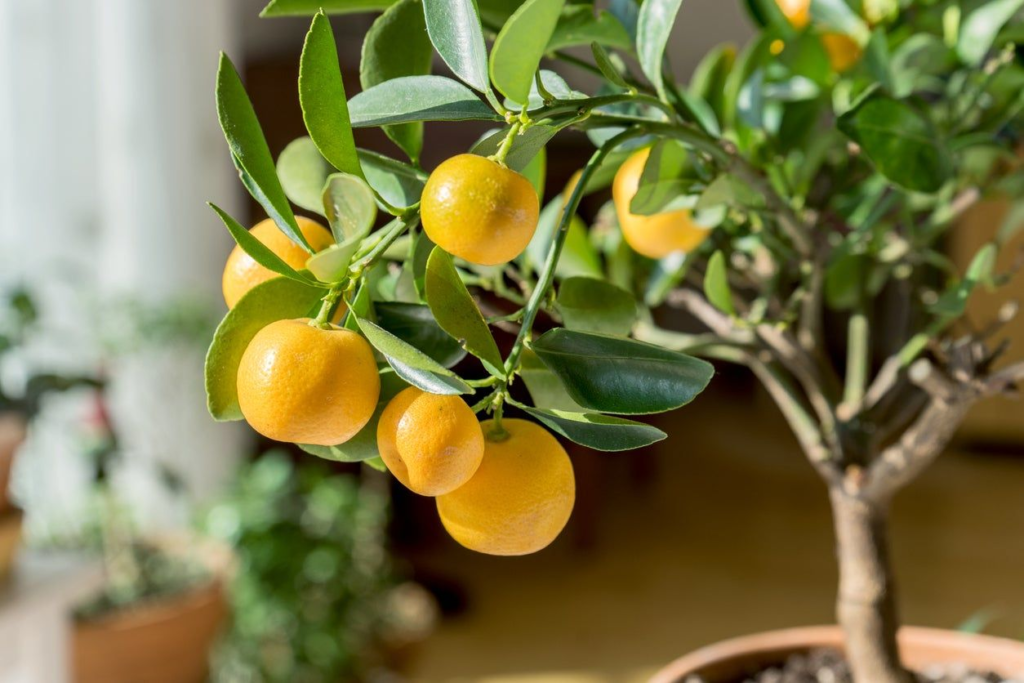
Humidity and Temperature Control
Citrus trees prefer higher humidity than typically found in most homes, especially during winter when heating systems dry indoor air:
- Ideal humidity: 40-60% relative humidity is optimal. Use a hygrometer to monitor levels in your home.
- Increasing humidity: Place your pot on a humidity tray filled with pebbles and water, use a room humidifier near the tree, or mist the foliage regularly (but not the blossoms when the tree is flowering).
- Temperature range: Maintain daytime temperatures between 65-75°F (18-24°C) and nighttime temperatures no lower than 55-60°F (13-16°C). Protect trees from cold drafts and heat sources like radiators or vents.
- Seasonal considerations: Most citrus varieties benefit from a slight temperature drop (5-10°F) during winter months to encourage flowering and fruiting cycles.
Pruning and Training
Regular pruning helps maintain the size and shape of your indoor citrus tree while promoting better air circulation and light penetration:
- When to prune: The best time for major pruning is late winter before the spring growth flush begins. However, you can remove dead or diseased branches any time of year.
- How to prune: Use clean, sharp pruning shears to make cuts at a 45-degree angle just above a leaf node. Focus on removing crowded interior branches, crossing limbs, and any growth that spoils the tree’s shape.
- Size control: To maintain a compact size suitable for indoor growing, prune back the longest branches by up to one-third their length annually.
- Root pruning: Every 2-3 years when repotting, gently trim the outer edges of the root ball by about 1-2 inches to encourage new root growth and prevent the tree from becoming root-bound.
Pollination and Fruit Production
One of the joys of growing citrus indoors is harvesting your own fresh fruit. Understanding the pollination requirements and fruiting cycles will help ensure successful harvests.
Self-Pollinating Varieties
Fortunately, most common indoor citrus varieties are self-fertile, meaning they don’t require a separate tree for pollination:
- Meyer lemons, Key limes, and Calamondins are particularly reliable self-pollinators, often producing fruit with no intervention.
- Even self-fertile varieties benefit from some assistance with pollination when grown indoors where natural pollinators are absent.
- When your tree flowers, gently shake the branches daily or use a small, soft paintbrush to transfer pollen between flowers, mimicking the work of bees and insects.
From Flower to Fruit
Understanding the fruiting cycle helps set realistic expectations for your indoor harvest:
- Blooming period: Most citrus trees bloom primarily in spring, though some varieties like Meyer lemons may flower intermittently throughout the year.
- Fruit development: Depending on the variety, fruits take anywhere from 4-12 months to fully ripen after flowering. Be patient—citrus fruits do not continue to ripen once picked.
- Thinning fruits: If your young tree produces an abundance of fruits, consider removing some to prevent branch breakage and nutrient stress. A good rule of thumb is to leave one fruit for every 8-10 leaves.
- Harvesting cues: Color change is the most obvious indicator of ripeness, but gently squeeze the fruit as well—it should yield slightly to pressure when ripe. Some varieties, like Meyer lemons, may stay on the tree for months after ripening.
Troubleshooting Common Issues
Even with proper care, indoor citrus trees sometimes encounter problems. Recognizing the signs early allows for prompt intervention.
Pest Management
Indoor citrus can attract several common pests:
- Spider mites: These tiny pests cause stippled, yellowing leaves and fine webbing. Increase humidity and treat with insecticidal soap or neem oil.
- Scale insects: These appear as small bumps on stems and leaf undersides. Remove them with a cotton swab dipped in rubbing alcohol and treat with horticultural oil.
- Mealybugs: These white, cottony pests cluster in leaf axils and under leaves. Remove with alcohol-soaked cotton swabs and spray with insecticidal soap.
- Aphids: These small, soft-bodied insects cluster on new growth. Rinse them off with a strong spray of water and apply insecticidal soap if infestations persist.
For environmentally friendly pest control methods, the Environmental Protection Agency offers guidance on integrated pest management for indoor plants. Visit the EPA’s Integrated Pest Management website for more information.
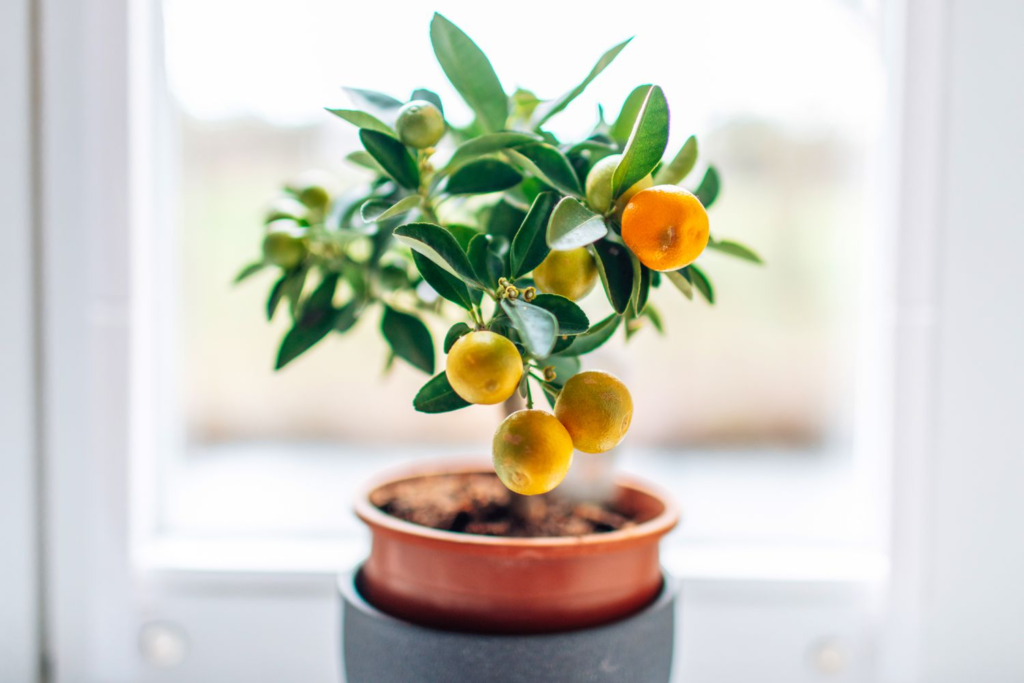
Disease Prevention
Several diseases can affect indoor citrus:
- Root rot: Caused by overwatering, symptoms include yellowing leaves and wilting despite wet soil. Repot in fresh soil if caught early.
- Citrus canker: This bacterial disease causes raised, corky lesions on leaves, stems, and fruit. Remove affected parts immediately to prevent spread.
- Leaf drop: Some seasonal leaf drop is normal, but excessive dropping may indicate improper watering, drafts, or sudden temperature changes.
- Nutrient deficiencies: Yellowing leaves or unusual patterns may indicate specific nutrient deficiencies. A citrus-specific fertilizer usually addresses these issues.
Seasonal Care Calendar
Your indoor citrus trees have different needs throughout the year. Follow this seasonal guide for optimal care:
Spring (March-May)
- Increase watering as days lengthen and growth resumes
- Resume regular fertilization schedule
- Move trees outdoors gradually once temperatures consistently exceed 50°F (10°C)
- Check for pests that may become active with warmer weather
Summer (June-August)
- Monitor water needs closely, as trees may require more frequent watering
- Provide afternoon shade if trees are outdoors
- Continue regular fertilization
- Watch for signs of heat stress if temperatures exceed 90°F (32°C)
Fall (September-November)
- Gradually acclimate trees to indoor conditions before first frost
- Inspect thoroughly for pests before bringing indoors
- Reduce fertilization frequency as growth slows
- Begin supplementing with grow lights as daylight hours decrease
Winter (December-February)
- Reduce watering frequency but never allow soil to completely dry out
- Provide supplemental lighting for 12-14 hours daily
- Maintain humidity levels with humidifiers or pebble trays
- Protect from cold drafts and heat sources
Conclusion
Growing citrus trees indoors can be a rewarding experience that brings a touch of the tropics to your home year-round. With the right varieties, proper care, and a bit of patience, you can enjoy the fragrant blossoms and fresh fruit of these remarkable trees regardless of your climate. Remember that each tree has its own personality and may require some adjustments to care routines based on your specific indoor environment.
By following the guidelines in this article and observing your trees closely, you’ll develop the intuition needed to provide optimal care. Before long, you’ll be enjoying the unparalleled flavor of freshly harvested citrus from your own indoor orchard—a truly satisfying accomplishment for any indoor gardener.
Start with one of the recommended varieties, provide ample light, and maintain consistent care. Your indoor citrus adventure awaits!
